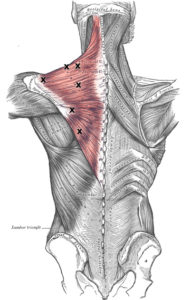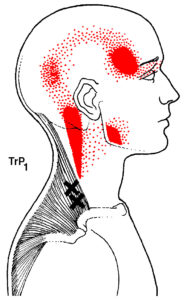Trigger Point Therapy
Release muscle restrictions
All sessions are personalized to suit the individual and may incorporate a variety of techniques. Specifically to help ease chronic pain.



According to the leading researchers on trigger points and the doctor that coined the term “myofascial trigger point”, a trigger point is a “hypersensitive nodule within a taut band of tissue that can refer pain”.
Trigger points, also known as myofascial trigger points, are areas of hyperirritability in the soft tissue structure. These can be acute sources of pain, unnoticed by the client until pressure is applied by the practitioner.

Trigger points are manifested as small contractions, or knots in the muscle fibers. Contraction at a trigger point causes the surrounding muscle fibers to become taut and rope like.
One of the clinical features of a trigger point is its ability to refer pain in a predictable pain pattern which has been clearly mapped out. This mapping allows us to precisely locate the trigger point within the tight bands of muscle at the causative area.
They can be a major cause of musculoskeletal pain, causing or contributing to headaches, neck and jaw pain, menstrual pain, low back pain, the symptoms of carpal tunnel syndrome and tennis elbow, and many kinds of joint pain mistakenly ascribed to arthritis, tendonitis, bursitis, or ligament injury.
History of Trigger Points
Trigger points were first described by Dr Janet Travell, the personal rheumatologist to President John F. Kennedy, in 1942. So highly regarded, she was the White House physician over two presidencies starting with John F. Kennedy.
In 1960 she teamed up with Dr David Simons and continued to research and work on trigger points. In 1982 they wrote the robust “bibles” on trigger points, “Myofascial Pain and Dysfunction. The Trigger Point Manual” volumes 1 and 2.
Dr Travell spent her whole lifetime studying & researching Myofascial Trigger Points (MTrP’s) up until her passing at 95 years’ old. She was regarded the world over as the foremost expert in this field.
She stated, “around 75% of pain clinic patients have a trigger point as the sole source of their pain”.
Types of Trigger Points
There are 3 types of trigger points, being active trigger points, latent trigger points and satellite trigger points.
Active trigger Points
Active trigger points are defined as causing pain when no pressure is placed on them. So this means they are painful even if you aren’t massaging them. This is one of the most common causes of Myofascial pain and can be experienced anywhere in the body.
Common examples of active trigger points are headaches, neck pain, back pain including sciatica, knee pain and so on.
As in the picture above the X marks the spot where you press and the red area is the referral pain pattern. This is helpful in diagnosing where the trigger point is.
Latent Trigger Points
A Latent trigger point is a point you press on that causes pain and often refers pain to another area. These points are seen as the precursor to active trigger points. If you have latent trigger points that get worse through further strain then they can become active trigger points and that is when you usually feel pain and need someone to help you get out of the pain.
Satellite Trigger Points
A satellite trigger point is the area where the pain is referred to. For example if you were getting pain in your shoulder and you found that the trigger point was in your shoulder referring to the elbow, the elbow points would be the satellite trigger points. So you would also work on these elbow points as they will be involved as well. This is why it is important to work on more than just the area that is painful.
How is a trigger point diagnosed?
There are 4 main criteria to diagnose a trigger point.
1. A taut band within the muscle fibre
2. An area that is sensitive to pressure within that taut band of tissue
3. The point refers pain or sensation to another area ie: you press on the trapezius muscle and you feel it radiate into the head, causing a headache.
4. A twitch response in the muscle that is pressed on or dry needled.
Symptoms of a Trigger Point
So how do you know it is a trigger point and not a bone or nerve? There are some common symptoms you will get that can differentiate trigger point pain:
- The nodule or band you are pressing on is in a muscle and not on the bone or nerve.
- The point you press on refers pain. This is not like nerve pain as when you press on a nerve it is like an electric shock or pins and needles. A trigger point referral isn’t like this. It is more of a dull pain that radiates.
- You have muscle pain that won’t go away and even gets worse when you move or exercise.
- You have chronic muscle pain.
What is referral pain?
There are a few ideas that suggest that the referral pain you experience is happening in the brain. It is like “crosstalk” you get in electrical cables that are close to each other. This can happen in the brain where areas of sensation in the brain are close to each other. For instance, if the trigger point is in the glutes, and refers down the leg, the area of the leg is close to that area in the brain and that is why you feel it there.
Some simpler ideas are that the muscle may attach to the area you feel the referral, which is common and may be transmitted through the fascia or nerves.
What causes a Trigger Point?
There are a few ideas that have been shown to cause trigger points.
- Lack of nutrients in the tissue including oxygen. When the blood supply to parts of the muscle is reduced it can cause these nodules in the tissue that then cause pain.
- Overuse of a muscle through exercise, posture, working at a computer all day without breaks and repetitive movements can cause the muscle fibers to become chronically contracted which over time causes pain.
- Injury such as a strain to the muscle/fascia. When this heals it may leave trigger points.
- Poor sleeping habits, stress, anxiety, depressio
- Endocrine dysfunction, viral/bacterial infections, vascular disease, inflammation
- Disc injuries or degenerative conditions and injured or compressed spinal or peripheral nerves.
Your general state of health can also perpetuate trigger points or predispose you to developing them.
How Can We Deactivate Trigger Points?
Trigger Point Therapy aims to discover the trigger points and eradicate them. This is achieved through the direct application of digital pressure to the specific trigger point.
When I find the nodule within the taut band of tissue, I hold pressure on it until the pain starts to reduce. This may take from 30 seconds to a few minutes. If the trigger point is really chronic then it may take multiple sessions to release this pain. You can try this with a ball to help to release the trigger point. This method is also known as ischemic pressure with the idea to get the blood flow away, and then when you let go the blood flow rushes back in, drawing all of the new nutrients to the area.
Many of you may have already experienced this as a fading away of pain or sensation while I am working with you and you are focusing on your breath. As I apply pressure to trigger points, some clients ask me if I have released my pressure over the point to which I reply “no”. This is experiential evidence of being able to immediately release pain through digital pressure and breath. The pain just fades away. This can be a profoundly surprising and empowering experience.
What is the treatment?
Trigger point massage and myofascial release are soft tissue therapies that I work with to treat both short-term and long-term muscle damage and dysfunction.
The referred pain from trigger points occurs in predictable patterns which have been clearly mapped out. This mapping allows me to precisely locate the trigger point within the tight bands of muscle at the causative area.
Trigger point massage is the application of pressure to the identified areas of muscles to help break up solid knots that are stopping the muscle from functioning properly. The massage increases circulation and enables oxygen and nutrients to flow to the spot.
I use myofascial release massage to directly stretch the trigger point’s knotted muscle fibers. This separates the fibers of the muscle repeatedly so that they begin to slide against each other in a natural way as the muscle contracts and releases, helping to reset the muscle and restore it to proper condition.
If needed, I will make suggestions for lifestyle changes, and provide you with stretching and strengthening exercises, to assist in healing and prevention.
